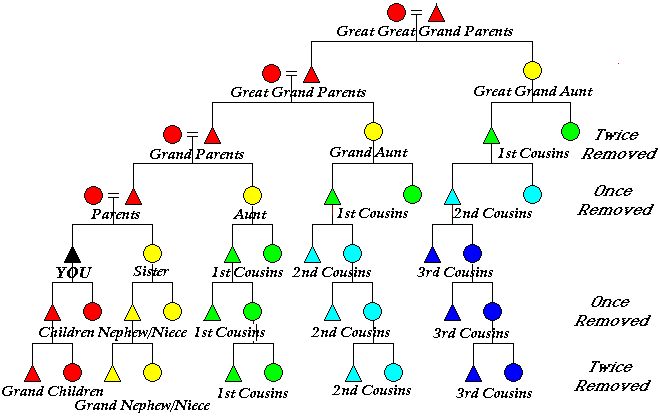
Just what is all that "once removed", "twice removed" stuff anyway?
There are two major types of cousin relationships: cousins of the same generation and cross-generational cousin relationships.
First, second, third (and on) cousins refer to cousins of the same generation.
The "removed" stuff refers to cousin relationships that cross generations. "Once removed" is shorthand for "one generation removed". "Twice removed" refers to "two generations removed". (And so on.)
(One thing to remember when we're talking genealogy is that people in the same generation share the same degree of relatedness with a given direct ancestor. For example, some of your first cousins may be 30 years younger than you are. Blood-wise, you're members of the same generation even though chronologically, you're in two different generations.)
Cousins of the Same (Blood) Generation
We know who are first cousins are -- we share a set of grandparents with them. Or, to put it another way, they're the children of our aunts and uncles. (And if Mom's sister Sue marries Dad's brother Sam, Uncle Sam and Aunt Sue's kids are our double first cousins, and we'd share both sets of grandparents.)
What about second cousins? Second cousins share a set of great-grandparents. The respective children of two first cousins are second cousins to each other.
And third cousins? The children of two second cousins are third cousins to each other. They share a set of great-great grandparents. (Sometimes, you'll hear the term "second great grandparents". It's the same thing.)
And the same logic applies for fourth and fifth cousins, and on down the line.
Cousins of Different (Blood) Generations
This is where the "once removed", "twice removed" stuff comes in. Remember, we talking about one generation removed, two generations removed, and so on... An example may help.
You and your first cousin Betty can each point to your grandparents' wedding photo and say, "That's Grandma Mary and Grandpa John" (even if you and Betty are 30 years apart in age). However, Betty's son Bill would refer to the couple in the photo as great-grandparents.
So, Bill is one generation further removed from Mary and John than you are. AND he is one generation removed from the first cousin relationship you have with Betty. Since you and Betty are first cousins, Betty's son Bill is also a first cousin, but he is a first cousin one generation removed ("once removed") because of the fact that he is Betty's son.
So, your first cousins once removed are always 1) the children of your first cousins, and 2) the first cousins of your mom and your dad.
To continue the example, Betty's son Bill grows up and has a daughter Debbie. The ancestors Debbie shares with you are Grandma Mary and Grandpa John. (They're YOUR grandparents, but they're Debbie's great-great grandparents.) So, Debbie is two generations removed from the first cousin relationship (sharing grandparents) you have with Betty. Debbie is thus your first cousin twice removed.
Your first cousins twice removed (that is, two generations removed) are always 1) the grandchildren of your own first cousins and 2) the first cousins of your grandparents.
The once and twice removed stuff also applies to second, and third (and on) cousins. Second cousins once removed are always 1) the children of your second cousins, and 2) your parents' second cousins.
Second cousins twice removed are always 1) the grandchildren of your second cousins, and 2) your grandparents' second cousins.
All the same rules apply to third, fourth and fifth cousins (and on down, increasingly distant), and to three times and four times removed (on down).
A tabular example is below:
Common Ancestors: John and Mary (husband and wife)
|
Robert |
Siblings (share parents) |
|
|
Betty |
Jim |
1st Cousins (share grandparents) |
|
Bill |
Anne |
2nd Cousins (share great-grandparents) |
|
Debbie |
Nina |
3rd Cousins (share great-great grandparents) |
|
Susan |
Tommy |
4th Cousins (share great-great-great grandparents) |
Betty, as Jim's first cousin, is the first cousin once removed of Jim's daughter Anne. She is a first cousin twice removed to Jim's granddaughter, Nina. And Tommy, who is Jim's great-grandson, is Betty's first cousin 3 times removed.
Likewise, Jim is the first cousin once removed of Betty's son Bill, the first cousin twice removed of Betty's granddaughter Debbie, and first cousin 3 times removed to Betty's great-granddaughter Susan.
Bill, as Anne's second cousin, is a second once removed to Anne's daughter Nina. (Bill is Mary and John's great-grandson, but Nina is a great-great granddaughter.) Bill is a second cousin twice removed to Tommy, Anne's grandson.
Debbie and Nina are third cousins to each other. Therefore, Debbie is a third cousin once removed to Nina's son Tommy, and Nina is a third cousin once removed to Debbie's daughter Susan.
Another example is presented schematically below:

Return to the
Voglewede Home Page